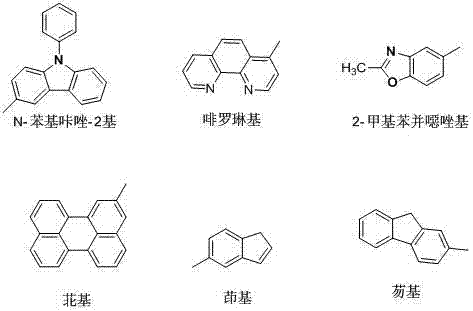Organic electroluminescent material containing benzanthracene derivative and preparation method of organic electroluminescent material
An electroluminescent material, benzanthracene technology, applied in the direction of luminescent materials, organic chemistry, chemical instruments and methods, etc., to achieve the effect of easy processing and increased solubility
- Summary
- Abstract
- Description
- Claims
- Application Information
AI Technical Summary
Problems solved by technology
Method used
Image
Examples
Embodiment 1
[0021] Embodiment 1: the synthesis of compound 001
[0022] Concrete synthetic route is as follows:
[0023]
[0024] Add 22.27g (50mmol) of fluorenyl-substituted benzanthracene bromide, 21.69g (75mmol) of N-phenylcarbazolylboronic acid, 10.60g (100mmol) of sodium carbonate, 250ml of tetrahydrofuran and 125ml of water into a three-necked flask and degas , add tetrakis(triphenylphosphine) palladium 0.58g (0.5mmol), raise the temperature to 70°C, react for 15 hours, cool to room temperature, after the solid precipitates, filter with suction, wash the filter cake with water, ethanol and ether, and dry After drying, 27.96 g of asymmetric benzanthracene derivatives were obtained, with a yield of more than 92% and an HPLC purity of more than 98%. Mass Spectrum: Calculated 607.74; Found 607.72. Elemental analysis: Calculated value: C: 92.89%; H: 4.81%; N: 2.30%; Tested value: C: 92.88%; H: 4.83%; N: 2.31%.
[0025]
Embodiment 2
[0026] Embodiment 2: the synthesis of compound 002
[0027] Concrete synthetic route is as follows:
[0028]
[0029] Add 22.27g (50mmol) of fluorenyl-substituted benzanthracene bromide, 17.92g (80mmol) of phenanthrene boronic acid, 12.19g (115mmol) of sodium carbonate, 250ml of tetrahydrofuran and 125ml of water into a three-necked flask, degas, and add four (three Phenylphosphorus) palladium 0.69g (0.6mmol), heated up to 80°C, reacted for 17 hours, cooled to room temperature, filtered with suction, washed the filter cake with water, ethanol and ether, and dried to obtain asymmetric 25.33 g of benzanthracene derivatives, the yield is over 93%, and the HPLC purity is over 98%. Mass spectrum: calculated value 544.64; found value 544.62. Elemental analysis: calculated value C: 90.42%; H: 4.44%; N: 5.14%; tested value C: 90.41%; H: 4.46%; N: 5.15%.
Embodiment 3
[0030] Embodiment 3: the synthesis of compound 003
[0031] Concrete synthetic route is as follows:
[0032]
[0033] Add 22.27g (50mmol) of fluorenyl-substituted benzanthracene bromide, 15.04g (85mmol) of 2-methylbenzoxazolylboronic acid, 13.78g (130mmol) of sodium carbonate, 250ml of tetrahydrofuran and 125ml of water into the three-necked flask, Degas, add tetrakis(triphenylphosphine)palladium 0.81g (0.7mmol), heat up to 85°C, react for 19 hours, cool to room temperature, after the solid precipitates, filter with suction, wash the filter cake with water, ethanol and ether , dried to obtain 23.14 g of asymmetric benzanthracene derivatives, the yield was over 93%, and the HPLC purity was greater than 98%. Mass spectrum: calculated value 497.58; found value 497.56. Elemental analysis: calculated value C: 89.31%; H: 4.66%; N: 2.81%; O: 3.22%; tested value C: 89.32%; H: 4.64%; N: 2.83%;
PUM
 Login to View More
Login to View More Abstract
Description
Claims
Application Information
 Login to View More
Login to View More - R&D
- Intellectual Property
- Life Sciences
- Materials
- Tech Scout
- Unparalleled Data Quality
- Higher Quality Content
- 60% Fewer Hallucinations
Browse by: Latest US Patents, China's latest patents, Technical Efficacy Thesaurus, Application Domain, Technology Topic, Popular Technical Reports.
© 2025 PatSnap. All rights reserved.Legal|Privacy policy|Modern Slavery Act Transparency Statement|Sitemap|About US| Contact US: help@patsnap.com



